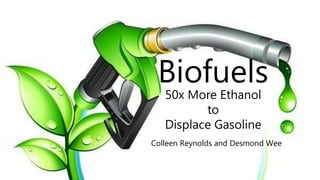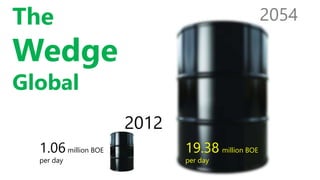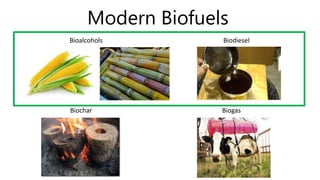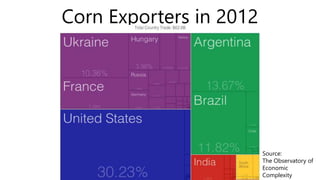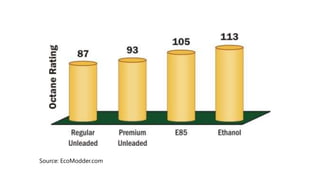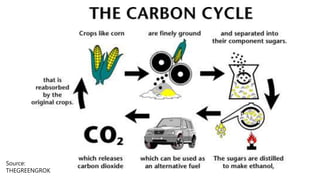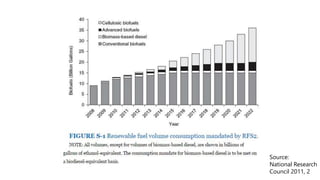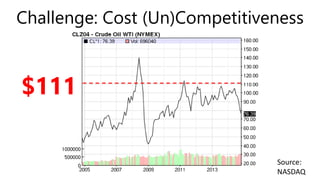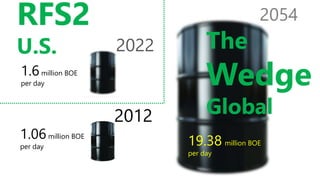Biofuels - 50x More Ethanol to Displace Gasoline
- 1. 28,000 barrels every 2 minutes Image: Oil Barrels, 2008, by Chris Jordan
- 2. Biofuels 50x More Ethanol to Displace Gasoline Colleen Reynolds and Desmond Wee
- 3. 1.06 million BOE per day 19.38 million BOE per day 2054 2012 The Wedge Global
- 4. 1/6 of global crop land
- 5. Modern Biofuels Bioalcohols Biodiesel Biogas Biochar
- 6. Corn Exporters in 2012 Source: The Observatory of Economic Complexity
- 9. Source: Alternative Fuels Data Center
- 11. Source: National Research Council 2011, 2
- 12. Cellulosic Ethanol Photo credit: Far Side of Fifty
- 13. The Problem of Cellulose Photo credit: welly76 Panoramio
- 15. Challenge: Cost (Un)Competitiveness Source: NASDAQ $111
- 16. 1.06 million BOE per day 19.38 million BOE per day 2054 2012 The Wedge Global 1.6 million BOE per day 2022 RFS2 U.S.
Editor's Notes
- #2: 28,000 âĶ âĶ. Thatâs the number of barrels of oil consumed in the United States every two minutes Thatâs 12,040 metric tons CO2 every 2 minutes We invite you to think about these numbers ___________________________________________________________ [20.16 million barrels every day]
- #3: We invite you to consider biofuels as part of the solution.
- #4: [Pacala and Socolow 2004, 971] Smaller, solid tank: global ethanol production rate in 2012 1.06 million BOE Larger, blurred tank: THE WEDGE by 2054 19.38 million BOE Hold this image and these numbers in your thought, weâll get back to them at the end of the presentation BOE: Barrel of oil equivalent, [onversion factor, since energy densities are different; the average energy content of a barrel of crude oil (5.8 MBtu)] _______________________________________ 1.86 million figure from: www.ethanolproducer.com/articles.10136/iea-predicts-globalglobal-ethanol-production 1 barrel of ethanol = .57 barrel of oil from BP (British Petroleum), which produces biofuels 1 barrel of biodiesel = .88 barrel of oil http://www.bp.com/en/global/corporate/about-bp/energy-economics/statistical-review-of-world-energy/using-the-review/Conversionfactors.html BOE: Vassiliou 2009, 554
- #5: 250 million hectares = 965,255 sq miles The total land area of the three largest US states: 987,651.88 sq miles = 255.8 million hectares Alaska: 570,640.95 sq miles Texas: 261,231.71 sq miles California: 155,779.22 sq miles Land area data from Table 18: http://www.census.gov/prod/cen2010/cph-2-1.pdf
- #6: What are biofuels? Renewable fuels that are derived from biomass (photosynthesis: sunlight) Fuel derived from any recently living biological organism or their metabolic byproducts. Fossi fuels donât count! Traditional biofuels have been with us for *ages*: firewood, charcoal, cow dung (in places like rural villages in India) 4 types of moden biofuels, presentation focuses on the 1st two: Bioalcohols & Biodiesel Desmond: 1st Generation Bioalcohol (US: corn ethanol*; Brazil: sugarcane ethanol) 2nd Generation Bioalcohol: Cellulosic ethanol* Colleen: Biodiesel* + Advanced biofuels* *FOCUS Mention in passing: Biochar: Agriculture refuse that can be burnt to generate electricity Biogas: Research by Argentinaâs National Institute of Agricultural Technology âAs much as 30% of Argentina's greenhouse gas emissions could come from cowsâ http://www.reuters.com/article/2008/07/09/us-argentina-cows-idUSN0830630220080709 Germany and other Northern European countries currently engages in commercial biogas upgrading and injection into the natural gas grid (Wellinger et al. 2013, 342-44) Today, weâre gonna focus on the 1st two types in the rectangle
- #7: The United States is the largest corn exporter, largest producer of corn ethanol Source: The Observatory of Economic Complexity Argentina launches corn ethanol plant (October 6, 2014) â policy-driven â ethanol mix increased from 5% to 10% in September: http://www.bnamericas.com/news/oilandgas/argentina-launches-corn-ethanol-plant Brazilian ethanol tax credit (September 10, 2014): http://www.bloomberg.com/news/2014-09-10/brazil-expands-tax-credit-to-ethanol-sugar-exporters.html
- #8: Ethanol is used as a gas additive, why? Raises octane level of gasoline. RFS 2005 encourages use of ethanol to increase octane rating (National Research Council 2011, 31) Reduces CO2 emissions with transportation fuel consumption (BUT needs to refined, so modest for corn ethanol) Gasoline containing up to 15% ethanol can be used without altering the construction of the engine BUT lowers energy density (reduces fuel mileage). Ethanol has about 30% lower energy density than pure gasoline (Speight 2010, 189) _________________________________________________________ 20% figure (Schnepf 2010, 4) Lowers energy density of 90/10 gas/ethanol blend by 3% (Geri and McNabb 2011, 23) Reduces fuel mileage (Speight 2010, 189)
- #9: [Fermentation = The growth of ethanol-producing yeasts is self-limiting because when the concentration of ethanol reaches about 14% it becomes toxic to the yeast cells.] Distilling fermentation slurry most energy intensive. Need to heat a lot of water. Corn ethanol emits more fuel production-related GHG emissions. Gasoline emits more tailpipe (end use) combustion-related GHG emissions Land use change? Lifecycle assessments are complicated. [Case in point: Page 202 of textbook (Bloom)] Image source: http://blogs.nicholas.duke.edu/thegreengrok/greenoptions4-30/
- #10: Image source (Alternative Fuels Data Center): http://www.afdc.energy.gov/vehicles/flexible_fuel_emissions.html
- #11: Letâs think about thisâĶ Food vs. Fuel debate 8 bushels of corn produces 22.4 gallons of ethanol OR enough food to feed a person for a whole year One bushel of corn produces 2.8 gallons of ethanol: http://www.ilcorn.org/ethanol/ethanol-faq#4 Conventional biofuels capped at 1.3 million barrels/day under RFS _________________________________________________________________ Image source: Investor Business Daily IBDeditorials cartoon
- #12: Conventional biofuels capped at 1.3 million barrels/day (National Research Council 2011, 2)
- #13: Corn stover feedstock in the United States. Cogeneration: produce cellulosic ethanol + corn ethanol at the same time Brazil: sugarcane bagasse. Non-edible feedstock: Negates Food vs. Fuel debate Higher GHG emissions savings compared to conventional biofuels (as already noted)
- #14: Paul Revere house in Boston. Built around 1680 (334 years). Illustrates problem with cellulose â great for building houses, BUTâĶ difficult to break down into sugars BECAUSE Cellulose is held together by hemicellulose (âdifficult sugarsâ) and lignin ___________________________________________________________ Shell sponsored an National Geographic article supporting thermochemical. Something to think about. POET-DSM Project Liberty Emmetsburg, Iowa Open since: September 3, 2014 Feedstock: Corn stover âOn October 17, 2014, Abengoa Bioenergy officially opened the worldâs largest cellulosic biorefinery in Hugoton, Kansas. âOf that biomass, more than 80 percent is expected to consist of irrigated corn stover, with the remainder comprised of wheat straw, milo stubble [a kind of grass or sorghum] and switchgrass. âThe plant is expected to hold the âworldâs largestâ title until the DuPont first commercial plant opens in Nevada, Iowa early in the new year.â BiofuelsDigest EPA â Obama proposed cuts to U.S. biofuel use targets, current event, still developing Wait-and-see attitude for future investors
- #15: 2 ways to break down the cellulose: Thermochemical conversion: older, based on paper-making technology. It can accommodate diverse materials, BUT thermochemical (as the name suggest) is energy intensive. Biochemical conversion: New technology. Proesa developed by Beta Renewables. Beta Renewables is a joint venture between Italian chemical company MG, Novozymes, and Texas Pacific Group. The 3 commercial-scale cellulosic ethanol plants in the U.S. use this approach. Disadvantage: Must be optimized for a particular feedstock Feedstock: Wheat straw, perennial grasses Pre-treatment: enzymes to break down cellulose can be costly. BUT cellulosic enzymes costs have decreased from $5/gallon to $0.60/gallon through 10+ years of R&D. The cost of the product is competitive compared to oil (70 dollars / barrel). Hydrolysis: break down the cellulose into sugars Processes in rectangle are similar to Gen 1 Technology SSCF = Simultaneous saccharification and co-fermentation Saccharification = hydrolysis of cabohydrates Distillation + dehydration
- #16: According to the National Research Council, biofuels could be cost-competitive with petroleum-based fuels, only in an economic environment characterized by: High oil prices Technological breakthrough High implicit or actual carbon price The council used $111 as the crude oil price to construct a breakeven model, but cellulosic biofuels are still uncompetitive without policy incentives. Thereâs a huge price gap between what the biorefineries are willing to pay for feedstock and what the suppliers of feedstock are willing to accept. In the past decade, only twice did the crude oil price hit above $111. With the EPA under the Obama administration proposing cuts to U.S. biofuel use targets and oil trading around $76 a barrel, do we have better options? Colleen will answer this question for us! Graph source: http://www.nasdaq.com/markets/crude-oil.aspx?timeframe=10y [11/4/14 12:25 p.m.]


